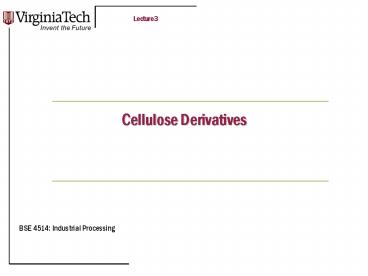Cellulose Derivatives PowerPoint PPT Presentation
1 / 12
Title: Cellulose Derivatives
1
- Cellulose Derivatives
BSE 4514 Industrial Processing
2
UV Stability
- UV stability is relative, i.e., all polymers are
highly susceptible to UV degradation - with the exception of fluoropolymers, most
polymers are susceptible to oxidation,
particularly at high temperature and UV, J.R.
Fried, Polymer Science and Technology, Prentice
Hall, 1995, p. 239. - Aliphatic polyesters are more UV stable than
aromatic polyesters and chains of hydrocarbons
b/c - Ester groups absorb less UV radiation than phenyl
rings, CC, or C-C (I was told this and I still
do not understand what it means physically, but
there are other ways to rationalize!) - UV degradation is an oxidative process, i.e., it
runs in the presence of O2. Esters already
contain oxygen and when CC and C-C are
oxidatively degraded, they degrade to CO, which
esters already contain so esters can be though of
as oxidized olefins. Phenyl groups, like in PS
or PETE, absorb lots of UV radiation and transfer
it to the main polymer chain so these polymers
are highly susceptible to UV degradation.
3
UV Stability
- CO is a polar group and the polarity stabilizes
it relative to non-polar groups like C-C and CC - The bond energy of CO is 0.75 MJ/mol, CC is
0.61 MJ/mol and C-C is 0.33 MJ/mol so this is a
much more stable bond - PE and PP, for instance, are polymerized using
free radicals (LDPE) or transition metal
catalysts (HDPE, PP). Residual catalyst usually
remains following polymerization. Although free
radicals can combine, they can be re-initiated
with UV light. So UV will activate residual
catalyst and depolymerize (or in some cases
cross-link or continue to polymerize) the
polymer. - PHA is polymerized through enzyme catalyzed
bacterial synthesis so there is no residual
catalyst to be re-activated by UV radiation. - PHA and PLA are of very high crystallinity and
crystalline regions UV degrade slower than
amorphous regions.
From Pol. Deg. Stab., 91, 1128-1137, 2006.
4
Cellulose
- textile fibers (cotton, flax, etc.)
- paper (pulping)
- building (wood)
- polymers renewable resource but not benign
processing (we only want to mention but not
concentrate on) - composites good app, green materials
5
Cellulose
You remember this structure!
In these rxns, DSdegree of substitution is
important DS0-3/glucose The DS is dependent on
the availability of OH groups so it is a function
of the H-bonding in cellulose!
6
Cellulose Derivatives
- Derivatize or functionalize hydroxyls (OH)
- Similar rxns can be done on starch (glucose
subunit in both) but these materials were
abandoned b/c of inferior properties relative to
cellulose derivatives - Three examples 1) viscose, 2) cellulose acetate
(esters), 3) carboxy methyl cellulose (ethers) - All cellulose derivatives are variations on these
reactions
7
Viscose Process
To make Rayon fiber or cellophane film classic
products from a classic process
Need base to break up cellulose H-bond structure
to make C-OH available
S
C-O-C
-
cellulose NaOH CS2
S-Na
C-OH based fiber
spin fiber
salt
acid bath
Used to make a lot of, now not so much in US b/c
requires strong base, strong acid, and CS2
8
Viscose Process
While CS2 is naturally produced in small
quantities from the enzymatic degradation of
proteins in the environment, in concentrated
quantities it is lethal (and you dont need much)
Toxicology Poison - may be fatal if swallowed or
inhaled. Serious health hazard, affecting the
Central Nervous System (CNS). Readily absorbed
through the skin. Sufficient material may be
absorbed through the skin to be fatal. May cause
reproductive damage, including imparing
fertility. Chronic exposure may cause liver,
kidney and CNS damage, or impaired vision. Causes
burns. Severe eye and respiratory irritant. Skin
irritant. Typical PEL 7 ppm. Toxicity
data IHL-HMN LCLO 4000 ppm/30m IPR-GPG LDLO 400
mg kg-1 IHL-MAM LCLO 2000 ppm/5m ORL-RAT LD50
3188 mg kg-1 ORL-MUS LD50 2780 mg kg-1 ORL-RBT
LD50 2550 mg kg-1 IHL-MUS LC50 10000 mg/m3/2h0
100
from CS2 MSDS
9
Cellulose Acetate
Esters commercially made by Eastman. Mostly short
fibers for non-wovens like cigarette butts!
O
Relies on acetylated OH groups
ester linkages!
C
-
-
O-
-C
partial
cellulose acetic acid acetic anhydride H2SO4
hydrolysis
dissolve in acetone and spin fiber
This is another gt 100 yr old process like viscose
and had not changed much. Cellulose will react
under anhydrous conditions in the presence of
acid catalyst w/ acetic anhydride to form
cellulose tri-acetate. Cellulose acetate is the
partially acetylated rxn product of high purity
cellulose and acetic anhydride. It is obtained
by acid catalyzed hydrolysis of the tri-acetate
to a DSav2.4 (cellulose tri-acetate would be
DS3.0)
from Nexant Outlook on Chemical Industry
10
Cellulose Acetate
C-OH
(CH3CO)2O
C-OOCCH3
CH3COOH
OH group on cellulose
H2SO4
acetic anhydride
cellulose tri-acetateester
acetic acid (H from cellulose OH)
(sulfuric acid)
acetic anhydride is split in 1/2
C-OOCCH3
0.2H2O
this is fully acetylated cellulose
hydrolysis
cellulose tri-acetateester
C-(OOCCH3)0.8
0.2CH3COOH
acetic acid
(OH)0.2
cellulose acetateester
DS3(0.8)2.4/glucose can be v. high!
This material is soluble in acetone and other
organic solvents Properties, like
biodegradability, are f(DS) remember, the
biggest impediment to this rxn is the
availability of OHs from H-bonding
11
Carboxy methyl cellulose (CMC)
mostly food and drug applications some
packaging, adhesives, paints, paper binder
O
cellulose chloracetic acid
C-O-CH2-C
-
pHgt7
OH
ether bond
Organic acid (polar) solubilizes the cellulose by
breaking-up H-bonding. Acid groups functionalize
hydroxyls to form ether. DS0.6-0.9 some
cellulose chain cleavage b/c of strong acid and
base so Mw? This makes a H2O-soluble material!
12
Cellulose Derivative Properties
texg/1000 m (a measure of fiber diameter)
? in g/cm3

